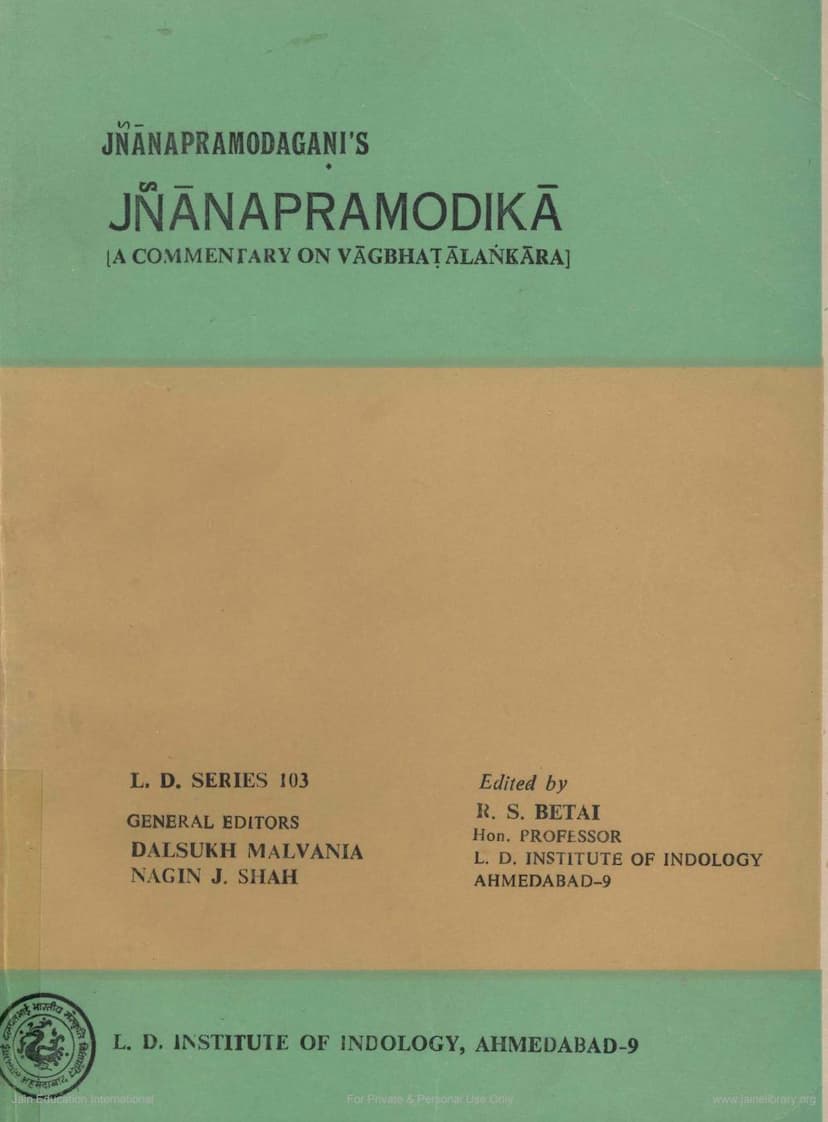Gyanpramodika
Added to library: September 1, 2025

Summary
Here's a comprehensive summary of the Jain text "Jñānapramodikā" by Jñānapramodagaṇi, based on the provided pages:
Book Title: Jñānapramodikā Author: Jñānapramodagaṇi Commentary on: Vāgbhaṭālaṅkāra (by Vāgbhaṭa) Publisher: L. D. Institute of Indology, Ahmedabad Editors: R. S. Betai (General Editors: Dalasukh Malvania, Nagin J. Shah) Publication Year: First Edition, March 1987
Overall Purpose:
The "Jñānapramodikā" is a significant commentary on Vāgbhaṭālaṅkāra, a prominent work on Sanskrit poetics. Jñānapramodagaṇi, a disciple of Ratnadhiragani, composed this commentary in V.S. 1681 (1624 CE). The work is highly regarded for its scholarly exposition, systematic and scientific treatment of Alankaras (figures of speech) and Rasa (aesthetic sentiment), and its critical analysis.
Key Aspects and Contributions:
- Scholarly Exposition: The commentary is praised for its deep and vast scholarship, exceeding that of earlier commentators like Simhadevagani. Jñānapramodagaṇi's interpretation aims to place Vāgbhaṭālaṅkāra in the correct perspective.
- Treatment of Alankaras:
- The author provides a simple, lucid, and clear analysis of almost all figures of speech, often delving into scholarly details.
- He meticulously analyzes Vāgbhaṭa's illustrations, ensuring they further clarify the definitions.
- He frequently compares and contrasts figures of speech to highlight similarities and differences, aiding in better understanding.
- Jñānapramodagaṇi quotes parallel definitions from prominent poets and scholars like Vamana, Daṇḍin, Rudraṭa, and Mammaṭa.
- A notable feature is his extensive use of parallel illustrations from over 40 works of poetry and philosophy, often justifying them with authorities like Mallinātha's commentary on Magha's Śiśupālavadha.
- He critically engages with figures not accepted by Vāgbhaṭa, either rejecting some or including them within accepted categories based on relevance (Sāśraya). He seems to follow Hemacandra in this regard, even criticizing him at times (e.g., on the definition of Vṛtti).
- His analysis is considered "ultra-modern" and comparable to that found in modern scholarly works.
- Treatment of Rasa:
- Jñānapramodagaṇi acknowledges the central importance of Rasa in poetry, following the tradition of Rasa theorists.
- His treatment of Rasa is detailed, critical, and analytical, mirroring his approach to Alankaras.
- While acknowledging the established tradition of Rasa analysis (from Bharata to Anandavardhana and Abhinavagupta), he skillfully synthesizes the thinking of his predecessors, presenting it clearly and methodically.
- He expands on Vāgbhaṭa's outline, defining, analyzing, and illustrating Vibhāvas, Anubhāvas, and Vyabhicāribhāvas, and other technical terms, drawing from various sources, including dramas and Kavyas.
- His Vṛtti on Rasa is described as reading almost like a Bhāṣya (detailed commentary), providing a comprehensive gist of the subject.
- Methodology and Scholarship:
- The author demonstrates a thorough mastery of Sanskrit poetics, offering precise and to-the-point explanations.
- He possesses a strong command of grammar, frequently quoting Panini, Hemacandra, and other grammarians, though sometimes his grammatical discussions are considered over-elaborate or irrelevant.
- His vast reading is evident in his frequent references to and quotations from various Śāstras (philosophical and scientific treatises) and Jain śāstrakāras, alongside non-Jain ones.
- He shows a natural inclination towards Jaina philosophy and ethics, weaving them into his discussions.
- A fondness for etymology is noted, with some etymologies being imaginary while others are accurate.
- He makes particular use of the "Sarvapāṭīkā" (likely referring to commentaries like Mallinatha's) for justification and illustrations.
- Linguistic Style and Peculiarities:
- Explanations of words are often provided through synonyms.
- He habitually uses the present tense with the implication of the past tense.
- Illustrations often favor those related to Tirthankaras.
- He displays some "fantastic notions" about women and sex life, possibly influenced by his ascetic background.
- The Vṛtti is presented in a systematic manner, following the structure of Vāgbhaṭālaṅkāra, with detailed analysis of each Karika.
- Manuscript Usage and Critical Edition:
- The critical edition was based on four manuscripts: one from the Oriental Institute, Vadodara (V.S. 1697); one from the Hemachandra Jain Jñānabhandāra, Patan (V.S. 1710); one from the Bhandarkar Oriental Research Institute, Pune (age unknown); and one from the L. D. Institute of Indology, Ahmedabad (V.S. 1N43).
- The manuscript from the L.D. Institute (V.S. 1843) was chosen as the basic manuscript due to its completeness, legibility, and good condition, though other manuscripts were closer in age and value.
- Extensive cross-referencing and analysis of variant readings were conducted to produce the final critical edition.
- Comparison with Other Commentaries:
- The "Jñānapramodikā" is distinguished from earlier commentaries like Simhadevagani's (often considered routine and simple, particularly in later chapters) and Jinavardhanasuri's (brief and almost an Avacūri, primarily for introductory study).
- It is also contrasted with Merusundara Upadhyaya's "Balāvabodha," which is written in Sanskrit and Old Gujarati for beginners, making it simpler and more detailed in explanation but less scholarly.
- Jivananda Vidyasagara's commentary is noted as learned and original, making extensive use of parallel quotations and demonstrating boldness in views, especially on Dosas and Rasa, but perhaps not reaching the same scholastic heights as Jñānapramodagaṇi in Alankara analysis.
- Jñānapramodagaṇi's commentary is considered a significant addition to the published literature on Sanskrit Poetics, offering a superior analysis and interpretation.
Conclusion:
The "Jñānapramodikā" is a highly valuable work that not only sheds light on Vāgbhaṭālaṅkāra but also stands as a testament to Jñānapramodagaṇi's profound erudition, critical acumen, and dedication to the study of Sanskrit poetics. It is an important resource for scholars and students interested in the nuances of Alankaras and Rasa.